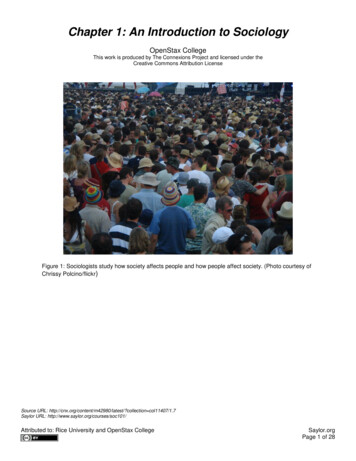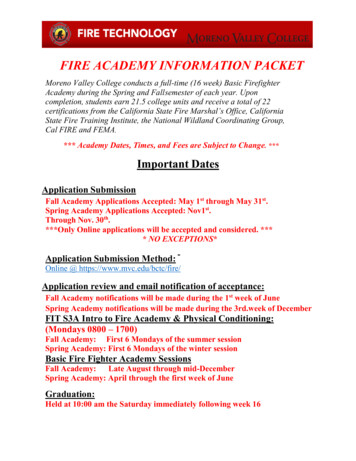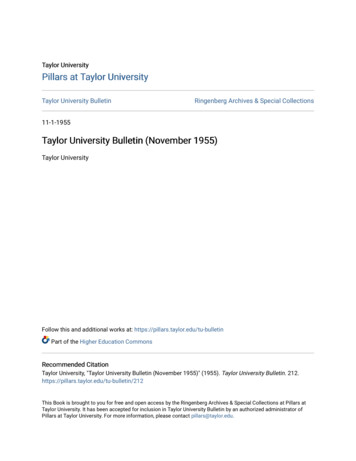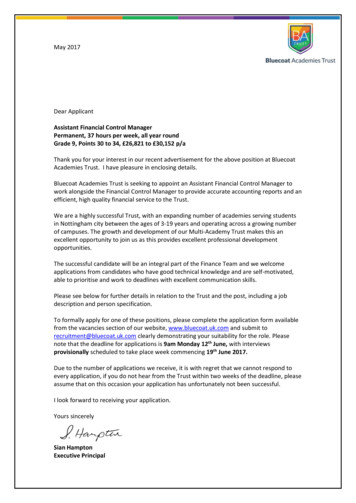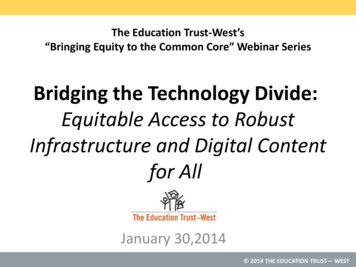
Transcription
This text was adapted by The Saylor Foundation under a CreativeCommons Attribution-NonCommercial-ShareAlike 3.0 License withoutattribution as requested by the work’s original creator or licensee.Saylor URL: http://www.saylor.org/booksSaylor.org1
OrganizationThe overarching logic of the book is intuitive—organized around answers to the what, where, why, andhow of international business.WHAT? Section one introduces what is international business and who has an interest in it. Students willsift through the globalization debate and understanding the impact of ethics on global businesses.Additionally, students will explore the evolution of international trade from past to present, with a focuson how firms and professionals can better understand today’s complex global business arena byunderstanding the impact of political and legal factors. The section concludes with a chapter onunderstanding how cultures are defined and the impact on business interactions and practices withtangible tips for negotiating across cultures.WHERE? Section two develops student knowledge about key facets of the global business environmentand the key elements of trade and cooperation between nations and global organizations. Today, withincreasing numbers of companies of all sizes operating internationally, no business or country can remainan island. Rather, the interconnections between countries, businesses, and institutions are inextricable.Even how we define the world is changing. No longer classified into simple and neat categories, the rapidchanges within countries are redefining how global businesses think about developed, developing, andemerging markets. This section addresses the evolving nature of country classifications and helps developa student’s ability to comprehend the rationale of how to analyze a specific country’s stage ofdevelopment—rather than just memorize which countries are emerging. Further, this section provides aunique approach and takes country-related “deep dives” that give greater detail about specific keycountries. This section ends with chapters devoted to providing accessible discussions of complexfinancial concepts within the global monetary system and the global capital markets, including currencyand global venture capital.WHY? Section three develops knowledge about how a student or organization can exploit opportunities inthat global environment. Students will learn about the fundamental choices they have in terms ofinternational expansion and why such choices matter. Using different models of internationalization andSaylor URL: http://www.saylor.org/booksSaylor.org2
global market assessment, they will also learn why international business opportunities vary in theirpromise and complexity. In this section, students also do a deeper dive into the topics of exporting,importing, and global sourcing since these are likely to be the first forms of international business astudent will encounter.HOW? Section four is devoted to strategy and entrepreneurship in a flattening world and how keyorganizational activities can be managed for global effectiveness. This part of the book shifts gears fromthe perspective of existing businesses to that of new business possibilities. Our objective is to highlightstrategy, entrepreneurship, and strategic and entrepreneurial opportunities in a flat and flattening world.Beyond the basics of international strategy and entrepreneurship, students will be exposed tointernational human resource management so that they can better understand the global war for talent.They will also develop good fundamental knowledge of international research and development,marketing, distribution, finance, and accounting.FeaturesEach chapter contains several staple and innovative features as follows: opening cases—cases that are relatively timeless from an international business perspective andcurrent and topical sidebars titled “Did You Know”—factoids about international business sidebars titled “Amusing Anecdote”—factoids about global marketing snafus and other mistakescoupled with related key international business facts sidebars titled “An Eye on Ethics,” which provide examples of the ethical issues that arise ininternational business chapter summaries end of chapter exercises based on AACSB learning standards—these exercises include reviewquestions, experiential exercises, ethical dilemmas, and exercises related to the opening chaptercase a closing section titled “Tools in Your Walkabout Kit” with specific and practical tools related tointernational businessSaylor URL: http://www.saylor.org/booksSaylor.org3
supplemental support materials by chapterAs you’d expect, our textbook also provides a set of end-of-chapter questions that are mapped to AACSBlearning standards, such that the instructor will be able to measure how well students are grasping coursecontent while ensuring alignment with the AACSB guidelines.We recognize that you have choices on textbooks for your course, but hope that our innovative approachto both essential global business content and technology delivery options will encourage you to join ourrevolution.Saylor URL: http://www.saylor.org/booksSaylor.org4
Chapter 1IntroductionWHAT’S IN IT FOR ME?1.What is international business?2.Who has an interest in international business?3.What forms do international businesses take?4.What is the globalization debate?5.What is the relationship between international business and ethics?This chapter introduces you to the study of international business. After reading a short case study onGoogle Inc., the Internet search-engine company, you’ll begin to learn what makes international businesssuch an essential subject for students around the world. Because international business is a vitalingredient in strategic management and entrepreneurship, this book uses these complementaryperspectives to help you understand international business. Managers, entrepreneurs, workers, for-profitand nonprofit organizations, and governments all have a vested interest in understanding and shapingglobal business practices and trends. Section 1.1 "What Is International Business?" gives you a workingdefinition of international business; Section 1.2 "Who Is Interested in International Business?" helps yousee which actors are likely to have a direct and indirect interest in it. You’ll then learn about some of thedifferent forms international businesses take; you’ll also gain a general understanding of the globalizationdebate. This debate centers on (1) whether the world is flat, in the sense that all markets areinterconnected and competing unfettered with each other, or (2) whether differences across countries andmarkets are more significant than the commonalities. In fact, some critics negatively describe the “worldis flat” perspective as globaloney! What you’ll discover from the discussion of this debate is that the worldmay not be flat in the purest sense, but there are powerful forces, also called flatteners, at work in theworld’s economies. Section 1.5 "Ethics and International Business" concludes with an introductorydiscussion of the relationship between international business and ethics.Opening Case: Google’s Steep Learning Curve in ChinaOf all the changes going on in the world, the Internet is the one development that many people believemakes our world a smaller place—a flat orflattening world, according to Thomas Friedman, PulitzerSaylor URL: http://www.saylor.org/booksSaylor.org5
Prize–winning author of The World Is Flat: A Brief History of the Twenty-First Century andThe Lexusand the Olive Tree: Understanding Globalization. Because of this flattening effect, Internet businessesshould be able to cross borders easily and profitably with little constraint. However, with few exceptions,cross-border business ventures always seem to challenge even the most able of competitors, Internetbased or not. Some new international ventures succeed, while many others fail. But in every venture themanagers involved can and do learn something new. Google Inc.’s learning curve in China is a case inpoint.In 2006, Google announced the opening of its Chinese-language website amid great fanfare. While Googlehad access to the Chinese market through Google.com at the time, the new site, Google.cn, gave thecompany a more powerful, direct vehicle to further penetrate the approximately 94 million householdswith Internet access in China. As company founders Larry Page and Sergey Brin said at the time,“Unfortunately, access for Chinese users to the Google service outside of China was slow and unreliable,and some content was restricted by complex filtering within each Chinese ISP. Ironically, we were unableto get much public or governmental attention paid to the issue. Although we dislike altering our searchresults in any way, we ultimately decided that staying out of China simply meant diminishing service andinfluence there. Building a real operation in China should increase our influence on market practices andcertainly will enhance our service to the Chinese people.”[1]A Big Market, Bigger ConcernsGoogle’s move into China gave it access to a very large market, but it also raised some ethical issues.Chinese authorities are notorious for their hardline censorship rules regarding the Internet. They take afirm stance against risqué content and have objected to The Sims computer game, fearing it would corrupttheir nation’s youth. Any content that was judged as possibly threatening “state security, damaging thenation’s glory, disturbing social order, and infringing on other’s legitimate rights” was also[2]banned. When asked how working in this kind of environment fit with Google’s informal motto of “Don’tbe evil” and its code-of-conduct aspiration of striving toward the “highest possible standard of ethicalbusiness,” Google’s executives stressed that the license was just to set up a representative office in BeijingSaylor URL: http://www.saylor.org/booksSaylor.org6
and no more than that—although they did concede that Google was keenly interested in the market. Asreported to the business press, “For the time being, [we] will be using the [China] office as a base fromwhich to conduct market research and learn more about the market.”[3]Google likewise sidestepped theethical questions by stating it couldn’t address the issues until it was fully operational in China and knewexactly what the situation was.One Year LaterGoogle appointed Dr. Kai-Fu Lee to lead the company’s new China effort. He had grown up in Taiwan,earned BS and PhD degrees from Columbia and Carnegie Mellon, respectively, and was fluent in bothEnglish and Mandarin. Before joining Google in 2005, he worked for Apple in California and then forMicrosoft in China; he set up Microsoft Research Asia, the company’s research-and-development lab inBeijing. When asked by a New York Timesreporter about the cultural challenges of doing business inChina, Lee responded, “The ideals that we uphold here are really just so important and noble. How tobuild stuff that users like, and figure out how to make money later. And ‘Don’t Do Evil’ [referring to themotto ‘Don’t be evil’]. All of those things. I think I’ve always been an idealist in my heart.”[4]Despite Lee’s support of Google’s utopian motto, the company’s conduct in China during its first yearseemed less than idealistic. In January, a few months after Lee opened the Beijing office, the companyannounced it would be introducing a new version of its search engine for the Chinese market. Google’srepresentatives explained that in order to obey China’s censorship laws, the company had agreed toremove any websites disapproved of by the Chinese government from the search results it would display.For example, any site that promoted the Falun Gong, a government-banned spiritual movement, wouldnot be displayed. Similarly (and ironically) sites promoting free speech in China would not be displayed,and there would be no mention of the 1989 Tiananmen Square massacre. As one Western reporter noted,“If you search for ‘Tibet’ or ‘Falun Gong’ most anywhere in the world on google.com, you’ll find thousandsof blog entries, news items, and chat rooms on Chinese repression. Do the same search inside China ongoogle.cn, and most, if not all, of these links will be gone. Google will have erased them completely.”Saylor URL: http://www.saylor.org/books[5]Saylor.org7
Google’s decision didn’t go over well in the United States. In February 2006, company executives werecalled into congressional hearings and compared to Nazi collaborators. The company’s stock fell, andprotesters waved placards outside the company’s headquarters in Mountain View, California. Googlewasn’t the only American technology company to run aground in China during those months, nor was itthe worst offender. However, Google’s executives were supposed to be different; given their lofty motto,they were supposed to be a cut above the rest. When the company went public in 2004, its founders wrotein the company’s official filing for the US Securities and Exchange Commission that Google is “a companythat is trustworthy and interested in the public good.” Now, politicians and the public were asking howGoogle could balance that with making nice with a repressive Chinese regime and the Communist Partybehind it.[6]One exchange between Rep. Tom Lantos (D-CA) and Google Vice President Elliot Schragewent like this:Lantos:You have nothing to be ashamed of?I am not ashamed of it, and I am not proud of it We have taken a path, we have begun on a path,we have done a path that will ultimately benefit all the users in China. If we determined,congressman, as a result of changing circumstances or as a result of the implementation of theGoogle.cn program that we are not achieving those results then we will assess our performance, our[7]Schrage: ability to achieve those goals, and whether to remain in the market.See the video “Google on Operating inside China” athttp://news.cnet.com/1606-2-6040114.html. In thevideo, Schrage, the vice president for corporate communications and public affairs, discusses Google’scompetitive situation in China. Rep. James Leach (R-IA) subsequently accuses Google of becoming aservant of the Chinese government.Google Ends Censorship in ChinaIn 2010, Google announced that it was no longer willing to censor search results on its Chinese service.The world’s leading search engine said the decision followed a cyberattack that it believes was aimed atgathering information on Chinese human rights activists.Saylor URL: http://www.saylor.org/books[8]Google also cited the Chinese government’sSaylor.org8
[9]restrictions on the Internet in China during 2009. Google’s announcement led to speculation whetherGoogle would close its offices in China or would close Google.cn. Human rights activists cheered Google’smove, while business pundits speculated on the possibly huge financial costs that would result from losingaccess to one of the world’s largest and fastest-growing consumer markets.In an announcement provided to the US Securities and Exchange Commission, Google’s founderssummarized their stance and the motivation for it. Below are excerpts from Google Chief Legal OfficerDavid Drummond’s announcement on January 12, 2010.[10]Like many other well-known organizations, we face cyberattacks of varying degrees on a regular basis. Inmid-December, we detected a highly sophisticated and targeted attack on our corporate infrastructureoriginating from China, resulting in the theft of intellectual property from Google. However, it soonbecame clear that what at first appeared to be solely a security incident—albeit a significant one—wassomething quite different.First, this attack was not just on Google. As part of our investigation, we have discovered that at leasttwenty other large companies from a wide range of businesses—including the Internet, finance,technology, media, and chemical sectors—have been similarly targeted. We are currently in the process ofnotifying those companies, and we are also working with the relevant US authorities.Second, we have evidence to suggest that a primary goal of the attackers was accessing the Gmail accountsof Chinese human rights activists. Based on our investigation to date, we believe their attack did notachieve that objective. Only two Gmail accounts appear to have been accessed, and that activity waslimited to account information (such as the date the account was created) and subject line, rather than thecontent of emails themselves.Third, as part of this investigation but independent of the attack on Google, we have discovered that theaccounts of dozens of US-, China- and Europe-based Gmail users who are advocates of human rights inChina appear to have been routinely accessed by third parties. These accounts have not been accessedSaylor URL: http://www.saylor.org/booksSaylor.org9
through any security breach at Google, but most likely via phishing scams or malware placed on the users’computers.We have taken the unusual step of sharing information about these attacks with a broad audience, not justbecause of the security and human rights implications of what we have unearthed, but also because thisinformation goes to the heart of a much bigger global debate about freedom of speech. In the last twodecades, China’s economic reform programs and its citizens’ entrepreneurial flair have lifted hundreds ofmillions of Chinese people out of poverty. Indeed, this great nation is at the heart of much economicprogress and development in the world today.The decision to review our business operations in China has been incredibly hard, and we know that it willhave potentially far-reaching consequences. We want to make clear that this move was driven by ourexecutives in the United States, without the knowledge or involvement of our employees in China whohave worked incredibly hard to make Google.cn the success it is today. We are committed to workingresponsibly to resolve the very difficult issues raised.The Chinese government’s first response to Google’s announcement was simply that it was “seeking moreinformation.”[11]In the interim, Google “shut down its censored Chinese version and gave mainlanders anuncensored search engine in simplified Chinese, delivered from its servers in Hong Kong.”[12]Like mostfirms that venture out of their home markets, Google’s experiences in China and other foreign marketshave driven the company to reassess how it does business in countries with distinctly different laws.Opening Case Exercises(AACSB: Ethical Reasoning, Multiculturalism, Reflective Thinking, Analytical Skills)1.Can Google afford not to do business in China?2. Which stakeholders would be affected by Google’s managers’ possible decision to shut down its Chinaoperations? How would they be affected? What trade-offs would Google be making?3. Should Google’s managers be surprised by the China predicament?Saylor URL: http://www.saylor.org/booksSaylor.org10
[1] Larry Page and Sergey Brin, “2005 Founders’ Letter,” Google Investor Relations, December 31, 2005, accessedOctober 25, nders-letter.html.[2] John Oates, “Chinese Government Censors Online Games,” Register, June 1, 2004, accessed November ina bans games.[3] Lucy Sherriff, “Google Goes to China,” Register, May 11, 2005, accessed January 25,2010, http://www.theregister.co.uk/2005/05/11/google china.[4] Clive Thompson, “Google’s China Problem (and China’s Google Problem),” New York Times, April 23, 2006,accessed January 25, google.html.[5] Clive Thompson, “Google’s China Problem (and China’s Google Problem),” New York Times, April 23, 2006,accessed January 25, google.html.[6] Larry Page and Sergey Brin, “2004 Founders’ IPO Letter,” Google Investor Relations, August 18, 2004, accessedOctober 25, -founders-letter.html.[7] Declan McCullagh, “Congressman Quizzes Net Companies on Shame,” CNET, February 15, 2006, accessedJanuary 25, 2010, nies-on-shame/2100-1028 36040250.html.[8] Jessica E. Vascellaro, Jason Dean, and Siobhan Gorman, “Google Warns of China Exit over Hacking,” January 13,2010, accessed November 12, 26659.html#ixzz157TXi4FV.[9] Tania Branigan, “Google to End Censorship in China over Cyber Attacks,” Guardian, January 13, 2010, accessedNovember 12, /12/google-china-ends-censorship.[10] David Drummond, “A New Approach to China,” Official Google Blog, January 12, 2010, accessed January 25,2010, h-to-china.html.[11] Tania Branigan, “Google Challenge to China over Censorship,” Guardian, January 13, 2010, accessed January25, /13/google-china-censorship-battle.[12] Harry McCracken, “Google’s Bold China Move,” PCWorld, March 23, 2010, accessed November les bold china move.htmlSaylor URL: http://www.saylor.org/booksSaylor.org11
1.1 What Is International Business?LEARNING OBJECTIVES1.Know the definition of international business.2.Comprehend how strategic management is related to international business.3.Understand how entrepreneurship is related to international business.The Definition of International BusinessAs the opening case study on Google suggests, international business relates to any situation where theproduction or distribution of goods or services crosses country borders. Globalization—the shift toward amore interdependent and integrated global economy—creates greater opportunities for internationalbusiness. Such globalization can take place in terms of markets, where trade barriers are falling and buyerpreferences are changing. It can also be seen in terms of production, where a company can source goodsand services easily from other countries. Some managers consider the definition of international businessto relate purely to “business,” as suggested in the Google case. However, a broader definition ofinternational business may serve you better both personally and professionally in a world that has movedbeyond simple industrial production. International business encompasses a full range of cross-borderexchanges of goods, services, or resources between two or more nations. These exchanges can go beyondthe exchange of money for physical goods to include international transfers of other resources, such aspeople, intellectual property (e.g., patents, copyrights, brand trademarks, and data), and contractualassets or liabilities (e.g., the right to use some foreign asset, provide some future service to foreigncustomers, or execute a complex financial instrument). The entities involved in international businessrange from large multinational firms with thousands of employees doing business in many countriesaround the world to a small one-person company acting as an importer or exporter. This broaderdefinition of international business also encompasses for-profit border-crossing transactions as well astransactions motivated by nonfinancial gains (e.g., triple bottom line, corporate social responsibility, andpolitical favor) that affect a business’s future.Strategic Management and EntrepreneurshipA knowledge of both strategic management and entrepreneurship will enhance your understanding ofinternational business. Strategic management is the body of knowledge that answers questions about theSaylor URL: http://www.saylor.org/booksSaylor.org12
development and implementation of good strategies and is mainly concerned with the determinants offirm performance. A strategy, in turn, is the central, integrated, and externally oriented concept of how anorganization will achieve its performance objectives.[1]One of the basic tools of strategy isaSWOT (strengths, weaknesses, opportunities, threats) assessment. The SWOT tool helps you take stockof an organization’s internal characteristics—its strengths and weaknesses—to formulate an action planthat builds on what it does well while overcoming or working around weaknesses. Similarly, the externalpart of SWOT—the opportunities and threats—helps you assess those environmental conditions that favoror threaten the organization’s strategy. Because strategic management is concerned with organizationalperformance—be that social, environmental, or economic—your understanding of a company’s SWOT willhelp you better assess how international business factors should be accounted for in the firm’s strategy.Entrepreneurship, in contrast, is defined as the recognition of opportunities (i.e., needs, wants, problems,and challenges) and the use or creation of resources to implement innovative ideas for new, thoughtfullyplanned ventures. An entrepreneur is a person who engages in entrepreneurship. Entrepreneurship, likestrategic management, will help you to think about the opportunities available when you connect newideas with new markets. For instance, given Google’s current global presence, it’s difficult to imagine thatthe company started out slightly more than a decade ago as the entrepreneurial venture of two collegestudents. Google was founded by Larry Page and Sergey Brin, students at Stanford University. It was firstincorporated as a privately held company on September 4, 1998. Increasingly, as the Google case studydemonstrates, international businesses have an opportunity to create positive social, environmental, andeconomic values across borders. An entrepreneurial perspective will serve you well in this regard.Spotlight on International Strategy and EntrepreneurshipHemali Thakkar and three of her fellow classmates at Harvard found a way to mesh the power of play withelectrical power. The foursome invented “a soccer ball with the ability to generate electricity,” Thakkarsaid.[2]Every kick of the ball creates a current that’s captured for future use. Fifteen minutes of play lightsa lamp for three hours.Saylor URL: http://www.saylor.org/booksSaylor.org13
Called the sOccket, the soccer ball can bring off-grid electricity to developing countries. Even better, thesoccer ball can replace kerosene lamps. Burning kerosene is not only bad for the environment because ofcarbon dioxide emissions but it’s also a health hazard: according to the World Bank, breathing kerosenefumes indoors has the same effects as smoking two packs of cigarettes per day.[3]How did the idea of sOccket emerge? All four students (Jessica Lin, Jessica Matthews, Julia Silverman,and Hemali Thakkar) had experience with developing countries, so they knew that kids love playingsoccer (it’s the world’s most popular sport). They also knew that most of these kids lived in homes thathad no reliable energy.[4]As of November 2010, the sOccket prototype cost 70 to manufacture, but the team hopes to bring the[5]cost down to 10 when production is scaled up. One ingenious way to bring costs down is to set upfacilities where developing-world entrepreneurs assemble and sell the balls themselves.At this point it’s also important to introduce you to the concepts ofintrapreneurship and the intrapreneur.Intrapreneurship is a form of entrepreneurship that takes place inside a business that is already inexistence. An intrapreneur, in turn, is a person within the established business who takes directresponsibility for turning an idea into a profitable finished product through assertive risk taking andinnovation. An entrepreneur is starting a business, while an intrapreneur is developing a new product orservice in an already existing business. Thus, the ideas of entrepreneurship can be applied not only in newventures but also in the context of existing organizations—even government.KEY TAKEAWAYS International business encompasses a full range of cross-border exchanges of goods, services, orresources between two or more nations. These exchanges can go beyond the exchange of money forphysical goods to include international transfers of other resources, such as people, intellectual property(e.g., patents, copyrights, brand trademarks, and data), and contractual assets or liabilities (e.g., the rightSaylor URL: http://www.saylor.org/booksSaylor.org14
to use some foreign asset, provide some future service to foreign customers, or execute a complexfinancial instrument). Strategic management is the body of knowledge that answers questions about the development andimplementation of good strategies and is mainly concerned with the determinants of firm performance.Because strategic management is concerned with organizational performance, your understanding of acompany’s SWOT (strengths, weaknesses, opportunities, threats) helps you better assess howinternational business factors should be accounted for in the firm’s strategy. Entrepreneurship is the recognition of opportunities (i.e., needs, wants, problems, and challenges) andthe use or creation of resources to implement innovative ideas. Entrepreneurship helps you think aboutthe opportunities available when you connect new ideas with new markets.EXERCISES(AACSB: Reflective Thinking, Analytical Skills)1. What is international business?2. Why is an understanding of strategy management important in the context of international business?3. Why is an understanding of entrepreneurship important in the context of international business?[1] {Author’s name retracted as requested by the work’s original creator or licensee} and William G.Sanders, Strategic Management: A Dynamic Perspective, Concepts and Cases (Upper Saddle River, NJ: PearsonEducation, 2007).[2] “Harnessing the Power of Soccer,” interview with Thakkar Hemali by Ike Sriskandarajah, October 20, 2010,accessed November 12, 2010,http://www.loe.
world's economies. Section 1.5 "Ethics and International Business" concludes with an introductory discussion of the relationship between international business and ethics. Opening Case: Google's Steep Learning Curve in China Of all the changes going on in the world, the Internet is the one development that many people believe




